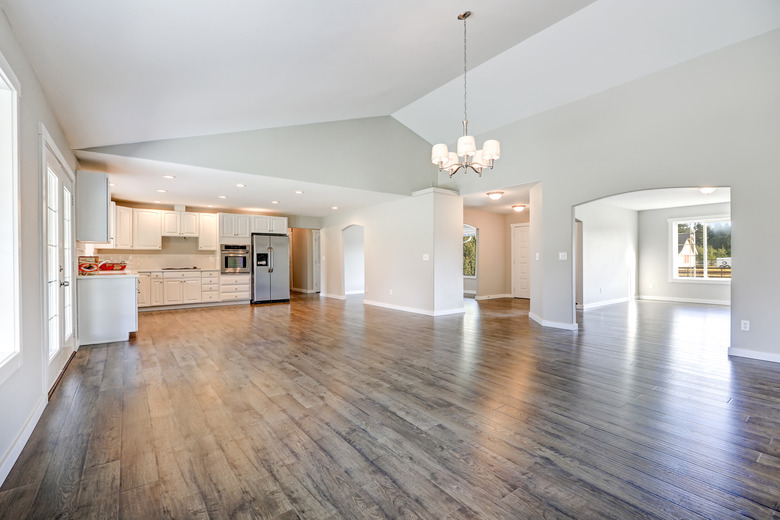How To Fix A Buckled Laminate Floor
We may receive a commission on purchases made from links.
Laminate floors buckle because they get wet; moisture seeps into the fiberboard core of a board and swells it, causing the board to push against the one next to it and curl upward. If you catch this problem quickly, you might dodge a bullet and get away without the need for extensive repairs, but that's rare. In most cases, after addressing the cause of the moisture, you end up having to replace the buckled boards.
Sources of Moisture
Sources of Moisture
Moisture can come from below, in the form of seepage through the subfloor, or from above, in the form of humidity or standing water. The floor should have been installed over a moisture barrier, but in some case, the barrier is inadequate — particularly if the subfloor is concrete. High humidity in the room can also seep into the laminate boards and cause swelling. Poor cleaning practices may also be responsible; although you should never use water to clean a laminate floor, some people regularly wet-mop their floor or — worse — use a steam cleaner. Both practices literally push water through the seams and into the core.
Swollen Laminate Boards
Swollen Laminate Boards
Because fiberboard swells when it gets wet, a wet laminate board pushes against the one next to it. If the floor was installed properly, there is an expansion gap around the perimeter than can absorb some of the movement, but if the gap isn't there, or if the baseboards are nailed to the floor instead of the wall, the floor can't expand, and swollen edges have no place to go but up. Buckled boards assume a decidedly unappealing concave shape, and in extreme circumstances they may even crack.
Addressing the Moisture Source
Addressing the Moisture Source
There's no point in repairing your buckling laminate floor until you find the source of the moisture and remedy it. The solution could be as simple as refraining from using water when cleaning the floor. If humidity is the problem, running a dehumidifier may help matters, but you'll need a longer-term solution if you don't want the problem to recur, such as ventilating the room or installing a central air system.
Fixing Buckled Laminate
Fixing Buckled Laminate
Once you've handled the cause of the moisture, you can decide what to do about the buckling. The repair may involve simply flattening a few boards, replacing a few or replacing the entire floor, depending on the amount of damage.
Minor Edge Curling
If poor cleaning practices or high humidity have cause minor buckling, the boards may return to normal on their own when things dry out. To speed the process, put weights, such as large cardboard boxes filled with books, on the curled boards to flatten them.
Damage to a Few Boards
Once boards have become misshapen, they need to be replaced. If the damage is confined to one or two boards, and you're sure the subfloor is dry, you can cut them out of the floor and replace them with new ones without having to replace the entire floor. The procedure involves cutting the damaged board lengthwise with a circular saw, chipping it out with a chisel and gluing in a new board in its place.
Major Damage or Subfloor Problems
If the moisture has affected more boards than is practical to replace, there is little else to do than to take up the entire floor and replace it. You have to do this — even if most boards are in good shape — to correct moisture problems in the subfloor.
Tip
In some cases, laminate may not have been the best choice of flooring. If the floor is in the basement, a garage, or a wet room, such as a laundry room or mudroom, you can avoid future problems by installing vinyl planks or luxury vinyl tiles instead of wood laminate.
Don't Forget the Expansion Gap
Don't Forget the Expansion Gap
When searching for the cause of the buckling, your inspection should include the edges of the floor. Remove the baseboards and check the gaps between the floor and the wall — if there isn't one, you need to make one. If you don't want to remove the entire floor — and who would? — use a rotary tool with a saw accessory to cut a 1/4-inch gap along the walls and around cabinets, doorways, and posts. Don't worry about making a perfect cut; as long as you keep the gap less than 3/8 inch, the baseboards will hide it.
